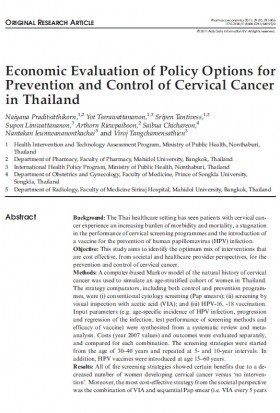This website uses cookies so that we can provide you with the best user experience possible. Cookie information is stored in your browser and performs functions such as recognising you when you return to our website and helping our team to understand which sections of the website you find most interesting and useful.
Economic Evaluation of Policy Options for Prevention and Control of Cervical Cancer in Thailand.(2011)

Details
Economic Evaluation of Policy Options for Prevention and Control of Cervical Cancer in Thailand
Naiyana Praditsitthikorn,1,2 Yot Teerawattananon,1,3 Sripen Tantivess,1,3 Supon Limwattananon,3 Arthorn Riewpaiboon,2 Saibua Chichareon,4
Nantakan Ieumwananonthachai5 and Viroj Tangcharoensathien3
1 Health Intervention and Technology Assessment Program, Ministry of Public Health, Nonthaburi, Thailand
2 Department of Pharmacy, Faculty of Pharmacy, Mahidol University, Bangkok, Thailand
3 International Health Policy Program, Ministry of Public Health, Nonthaburi, Thailand
4 Department of Obstetrics and Gynecology, Faculty of Medicine, Prince of Songkla University, Songkla, Thailand
5 Department of Radiology, Faculty of Medicine Siriraj Hospital, Mahidol University, Bangkok, Thailand
Background
The Thai healthcare setting has seen patients with cervical cancer experience an increasing burden of morbidity and mortality, a stagnation in the performance of cervical screening programmes and the introduction of a vaccine for the prevention of human papillomavirus (HPV) infection.
Objective
This study aims to identify the optimum mix of interventions that are cost effective, from societal and healthcare provider perspectives, for the prevention and control of cervical cancer.
Methods
A computer-based Markov model of the natural history of cervical cancer was used to simulate an age-stratified cohort of women in Thailand. The strategy comparators, including both control and prevention programmes, were (i) conventional cytology screening (Pap smears); (ii) screening by visual inspection with acetic acid (VIA); and (iii) HPV-16, -18 vaccination. Input parameters (e.g. age-specific incidence of HPV infection, progression and regression of the infection, test performance of screening methods and efficacy of vaccine) were synthesized from a systematic review and metaanalysis. Costs (year 2007 values) and outcomes were evaluated separately, and compared for each combination. The screening strategies were started from the age of 30–40 years and repeated at 5- and 10-year intervals. In addition, HPV vaccines were introduced at age 15–60 years.
Results
All of the screening strategies showed certain benefits due to a decreased number of women developing cervical cancer versus ‘no intervention’. Moreover, the most cost-effective strategy from the societal perspective was the combination of VIA and sequential Pap smear (i.e. VIA every 5 years for women aged 30–45 years, followed by Pap smear every 5 years for women aged 50–60 years). This strategy was dominant, with a QALY gain of 0.01 and a total cost saving of Baht (Bt)800, compared with doing nothing. From the societal perspective, universal HPV vaccination for girls aged 15 years without screening resulted in a QALY gain of 0.06 at an additional cost of Bt8800, based on the cost of Bt15 000 for a full immunization schedule. The incremental cost-effectiveness ratio, comparing HPV vaccinations for girls aged 15 years with the current national policy of Pap smears for women aged 35–60 years every 5 years, was approximately Bt181 000 per QALY gained. This figure was relatively high for the Thai setting.
Conclusions
The results suggest that controlling cervical cancer by increasing the numbers of women accepting the VIA and Pap smear screening as routine and by improving the performance of the existing screening programmes is the most cost-effective policy option in Thailand.
Link: http://adisonline.com/pharmacoeconomics/Abstract/2011/29090/Economic_Evaluation_of_Policy_Options_for.5.aspx




